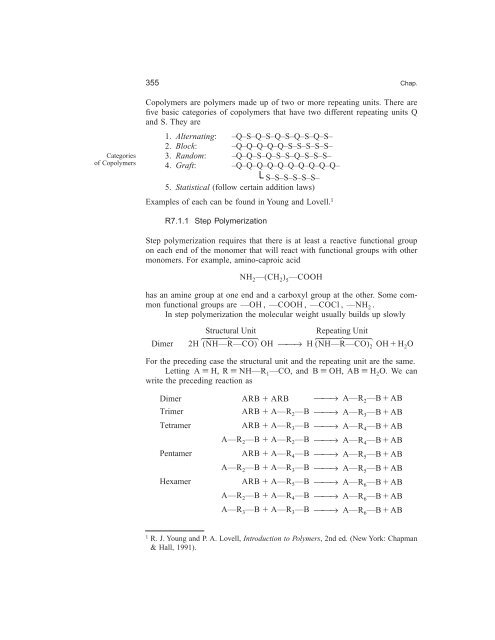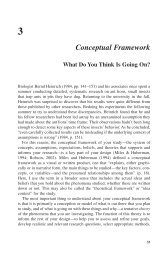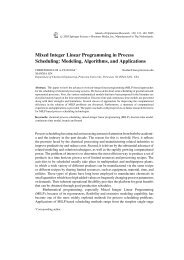R7.1 Polymerization
R7.1 Polymerization
R7.1 Polymerization
You also want an ePaper? Increase the reach of your titles
YUMPU automatically turns print PDFs into web optimized ePapers that Google loves.
Categories<br />
of Copolymers<br />
355<br />
Chap.<br />
Copolymers are polymers made up of two or more repeating units. There are<br />
five basic categories of copolymers that have two different repeating units Q<br />
and S. They are<br />
1. Alternating:<br />
–Q–S–Q–S–Q–S–Q–S–Q–S–<br />
2. Block:<br />
–Q–Q–Q–Q–Q–S–S–S–S–S–<br />
3. Random:<br />
–Q–Q–S–Q–S–S–Q–S–S–S–<br />
4. Graft:<br />
–Q–Q–Q–Q–Q–Q–Q–Q–Q–Q–<br />
S–S–S–S–S–S–<br />
5. Statistical (follow certain addition laws)<br />
Examples of each can be found in Young and Lovell. 1<br />
<strong>R7.1</strong>.1 Step <strong>Polymerization</strong><br />
Step polymerization requires that there is at least a reactive functional group<br />
on each end of the monomer that will react with functional groups with other<br />
monomers. For example, amino-caproic acid<br />
has an amine group at one end and a carboxyl group at the other. Some common<br />
functional groups are —OH , —COOH , —COCl , —NH2 .<br />
In step polymerization the molecular weight usually builds up slowly<br />
Dimer<br />
For the preceding case the structural unit and the repeating unit are the same.<br />
Letting A�H , R� NH—R1—CO,<br />
and B�OH , AB � H2O.<br />
We can<br />
write the preceding reaction as<br />
1<br />
Dimer<br />
Trimer<br />
Tetramer<br />
Pentamer<br />
Hexamer<br />
R. J. Young and P. A. Lovell,<br />
& Hall, 1991).<br />
NH2—CH ( 2)<br />
5 —COOH<br />
Structural Unit Repeating Unit<br />
2H ( NH—R—CO)<br />
OH ⎯⎯→ H ( NH—R—CO)<br />
2 OH� H2O<br />
⎫<br />
⎪<br />
⎪<br />
⎬<br />
⎪<br />
⎪<br />
⎭<br />
ARB � ARB<br />
ARB � A—R2—B ARB � A—R3—B A—R2—B � A—R2—B ARB � A—R4—B A—R2—B � A—R3—B ARB � A—R5—B A—R2—B � A—R4—B A—R3—B � A—R3—B ⎫<br />
⎪<br />
⎪<br />
⎬<br />
⎪<br />
⎪<br />
⎭<br />
⎯⎯→ A—R2—B�<br />
AB<br />
⎯⎯→ A—R3—B�<br />
AB<br />
⎯⎯→ A—R4—B�<br />
AB<br />
⎯⎯→ A—R4—B�<br />
AB<br />
⎯⎯→ A—R5—B�<br />
AB<br />
⎯⎯→ A—R5—B�<br />
AB<br />
⎯⎯→ A—R6—B�<br />
AB<br />
⎯⎯→ A—R6—B�<br />
AB<br />
⎯⎯→ A—R6—B�<br />
AB<br />
Introduction to Polymers,<br />
2nd ed. (New York: Chapman
















